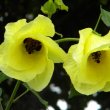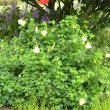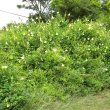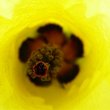Hibiscus ludwigii
| Botanical Name | Hibiscus ludwigii |
|||||||||||||||||||||
| Family | Malvaceae - The hibiscus and cotton family. |
|||||||||||||||||||||
| Pronunciation | hi-BIS-kus lud-WIG-ee-eye |
|||||||||||||||||||||
| Common Name(s) |
English: Hibiscus
Afrikaans: Roostou; Wildestokroos
|
|||||||||||||||||||||
| Plant Group |
|
|||||||||||||||||||||
| Plant Size |
|
|||||||||||||||||||||
| Position |
|
|||||||||||||||||||||
| General Information |
|
|||||||||||||||||||||
| Specific Information | Hibiscus ludwigii is a large, rounded, multi-stemmed perennial shrub, sprawling up to 3 meters across. Stems, which become woody as they age, are very tough and fibrous. Leaves are light green, quite large at about 8 cm across, with three to five lobes. Stems, leaves and fruits are covered with stiff, bristly, stinging hairs which can cause intense discomfort. Flowers hang singly, facing downwards and last for only one day. This species has not been much used in gardens, probably because of the discomfort it can cause. However, it is ideal for areas where it can ramble unfettered in boundary planting, golf courses, estates, reserves and large gardens. |
|||||||||||||||||||||
| Ad Break | ||||||||||||||||||||||
| Flowers | ||||||||||||||||||||||
| Description | bell shaped, about 10 cm across, with a purple spot in the throat |
|||||||||||||||||||||
| Season |
|
|||||||||||||||||||||
| Colour |
|
|||||||||||||||||||||
| Growth Rate |
|
|||||||||||||||||||||
| Plant Uses |
|
|||||||||||||||||||||
| Distribution and Habitat | in South Africa along the Eastern Cape and KwaZulu-Natal coasts, then further north through tropical east Africa up to Ethiopia and Eritrea, with small populations in the Cameroon and Ghana in west Africa, growing as an undershrub in forests and along the edges of forests, vleis, rivers and streams |
|||||||||||||||||||||
| Planting Suggestions | Hibiscus ludwigii is an excellent subject for a boundary or part of a background shrubbery. The plant is reported to prefer acidic soil conditions but is thriving in my slightly alkaline conditions. It is easily grown from seed or propagated from woody or green stem cuttings. Prune hard in autumn to keep the shrub dense, or allow it freedom to creep through the surrounding shrubbery. It does particularly well in a position facing north or east. A note about the stinging hairs: Cutting back and pruning of this shrub can be a bit of a trial. I usually wear long sleeves and jeans but the hairs still creep in everywhere and create a great deal of discomfort. Fortunately the hairs wash out of clothes and off the skin easily - a bath or shower immediately after working with the plant is probably a necessity. Individuals with sensitive skin should probably get someone else to do the pruning. Despite this bad press, the plant is very pretty, tough and needs no extra care. |
|||||||||||||||||||||
| Lorraine's Garden Notes | References: http://www.westfordbridge.co.za/flora/hibiscus_ludwigii.htm http://redlist.sanbi.org/species.php?species=2585-50 http://eol.org/pages/5413008/maps plants.jstor.org/upwta/4_47?history=true& http://apps.kew.org/efloras/namedetail.do?flora=fz&taxon=827&nameid=2083 tropical.theferns.info/viewtropical.php?id=Hibiscus+ludwigii |
|||||||||||||||||||||
| Medicinal Uses | Fibers from the inner bark of the stems were used for rope-making and in some parts of Africa the leaves are cooked and used as a vegetable. |
|||||||||||||||||||||
| Ad Break | ||||||||||||||||||||||









Comments
hibiscus ludwigii
I have mine growing on a west and south facing part of my garden, which gets a lot of summer sun. My three plants have spread to fill out an entire corner. Beautiful flowers.
hibiscus ludwigii
Since I was born the shrub grows wild near my home and we use it for treating ulcers and some times smearing the mud walls of our houses. I am Ugandan of bantu tribe. Thank you.
Discuss this plant
Share knowledge, ask a question or give an experience.